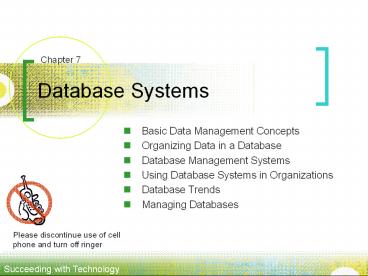Database Systems PowerPoint PPT Presentation
1 / 35
Title: Database Systems
1
Database Systems
Chapter 7
- Basic Data Management Concepts
- Organizing Data in a Database
- Database Management Systems
- Using Database Systems in Organizations
- Database Trends
- Managing Databases
2
The Value of Databases
- Databases and Database Management Systems (DBMS)
transform large quantities of data into specific
and valuable information for accomplishing some
goal.
3
7.1 Basic Data Management Concepts
4
Database Management System (DBMS)
- A DBMS consists of a group of programs that
manipulate the database and provide an interface
between the database and the user or the database
and application programs.
SecureAccess
Front End
Back End
5
Database
- A collection of data organized to meet users
needs.
6
Database Fields
- Fields are set to hold specific types of data.
7
Database
A Database is a collection of files/tables
8
Database Heirarchy
9
Keys and Primary Key
- Key A field in a record that is used to identify
the record - Primary key A field that uniquely identifies a
record - A primary key field prevents duplicate records
from occurring in a table.
10
Primary Keys
Which field would act as the best primary key?
11
Primary Keys
12
Simple but Restrictive DBMS
13
The Database Approach to Data Management
14
7.2 Organizing Data in a Database
15
The Relational Model
- In a relational database, tables are linked
(related) through common fields.
16
Relation Types
- One-to-many
- Most typical
- Makes use of primary key
- One-to-one
- Many-to-many
17
Data Analysis
- Data analysis is a process that involves
evaluating data to identify problems with the
content of a database. - Consider what would happen if CardNumber were not
a primary key, and two or more customers had the
same CardNumber. - Data Integrity refers to the accuracy of the data
in a database.
GIGO, or Garbage In Garbage Out, refers to the
fact that inaccurate data entered in a database
will result in inaccurate information produced
from the database.
18
Object Oriented Database
- An object-oriented database encapsulates the data
and the processing instructions together as
objects in the database.
19
7.3 Database Management Systems
20
Database Types
- Single User vs. Multiuser
- General-Purpose vs. Special-Purpose
- Open-Source
21
Creating a Database
- A schema is an outline the logical and physical
structure of the data and relationships among the
data in the database.
22
Creating a Database
- A data dictionary provides a detailed description
of all data used in the database.
23
Database Strengths
- Data can be sifted, sorted and queried through
the use of data manipulation languages.
24
Data Manipulation Language
- A Data Manipulation Language (DML) is a specific
language provided with the DBMS that allows
people and other database users to access,
modify, and make queries about data contained in
the database, and to generate reports. - Structured Query Language (SQL) The most popular
DML. - SELECT FROM EMPLOYEE WHERE JOB_CLASSIFICATION
C2
25
7.4 Using Database Systems in Organizations
26
Data Stores
- Data Warehouse A database that holds important
information from a variety of sources. - Data Mart A small data warehouse, often
developed for a specific person or purpose.
- Data Mining the process of extracting
information from a data warehouse. - Connecting the dots
27
Data Stores
28
Business Intelligence
- Business Intelligence is the use of data mining
to help increase efficiency, reduce costs, or
increase profits.
29
7.5 Database Trends
30
Databases and the Internet
- The Web is frequently used as the Front End of
DBMSs.
31
Distributed Database
32
Other Types of Databases
- Visual, audio, and unstructured database systems
organize non-textual data.
33
7.6 Managing Databases
34
Database Administrator
- A database administrator (DBA) is a skilled and
trained computer professionals who directs all
activities related to an organizations database,
including providing security from intruders.
35
Chapter 7 Questions?
- 1. What does SQL stand for?
- 2. What type of database is Access?
- 3. What is OO?
- 4. ______ is the process of extracting
information from a data warehouse. - Connecting the dots
- 5. ______ is a field that uniquely identifies a
record.

